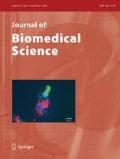Abstract
Microbial virulence is generally considered to be multifactorial with infection resulting from the sum of several globally regulated virulence factors. Estrogen may serve as a signal for global virulence induction inCandida albicans. Nonsteroidal estrogens and estrogen receptor antagonists may therefore have interesting effects on yeast and their virulence factors. Growth ofC. albicans was monitored by viable plate counts at timed intervals after inoculation into yeast nitrogen broth plus glucose. To determine if increased growth of yeast in the presence of estradiol was due to tyrosine kinase-mediated signaling, we measured growth in the presence of genistein, estradiol or genistein plus estradiol and compared these conditions to controls, which were not supplemented with either compound. Unexpectedly, genistein stimulated growth ofC. albicans. In addition, genistein was found to increase the rate of germination (possibly reflecting release from G0 into G1 cell cycle phase) and also increased Hsp90 expression, demonstrated by a dot blot technique which employed a commercial primary antibody detected with chemiluminescence with horseradish peroxidase-labeled secondary antibody. These biological effects may be attributable to genistein's activity as a phytoestrogen. In contrast, nafoxidine suppressed growth ofCandida and mildly diminished Hsp90 expression. This study raises the possibility of receptor cross-talk between estrogen and isoflavinoid compounds, and antiestrogens which may affect the same signaling system, though separate targets for each compound were not ruled out.
Similar content being viewed by others
References
Buckman J, Miller SM. Binding and reactivity ofCandida albicans estrogen binding protein with steroid and other substrates. Biochemistry 37:14326–14336;1998.
Burshell A, Stathis PA, Do Y, Miller SC, Feldman D. Characterization of an estrogen-binding protein in the yeastSaccharomyces cerevisiae. J Biol Chem 259:3450–3456;1984.
Feldman D, Tokes LG, Stethis PA, Miller SC, Kurz E, Harvey D. Identification of 17 beta-estradiol as the estrogenic substance inSaccharomyces cerevisiae. Proc Natl Acad Sci USA 81:4722–4726;1984.
Gale CA, Bendel CM, McClellan M, Hauser M, Becker JM, Berman J, Hostetter MK. Linkage of adhesion, filamentous growth, and virulence inCandida albicans to a single gene, INT1. Science 279:1355–1358;1998.
Gujjar PR, Finucane M, Larsen B. The effect of estradiol onCandida albicans growth. Ann Clin Lab Sci 27:151–156;1997.
Hodgetts S, Matthews R, Morrissey G, Mitsutake K, Piper P, Burnie J. Overexpression ofSaccharomyces cerevisiae hsp90 enhances the virulence of this yeast in mice. FEMS Immunol Med Microbiol 16:229–234;1996.
Improta-Brears T, Whorton AR, Codazzi F, York JD, Meyer T, McDonnell DP. Estrogen induced activation of mitogen activated protein kinase requires mobilization of intracellular calcium. Proc Natl Acad Sci USA 96:4686–4691;1999.
Krishnamurthy S, Gupta V, Prasad R, Panwar SL, Prasad R. Expression of CDR1, a multidrug resistance gene ofCandida albicans: Transcriptional activation by heat shock, drugs and human steroid hormones. FEMS Microbiol Lett 160:191–197;1998.
Lee KL, Buckley HR, Campbell CC. An amino acid synthetic medium for the development of yeast and mycelial forms ofCandida albicans. Sabouraudia 13:148–153;1975.
Mairessa N, Reiss N, Galand P, Kaye AM. Nafoxidine-responsive uterine protein: Further characterization and distinction from the ‘estrogen-induced’ protein (IP). Mol Cell Endocrinol 24:53–63;1981.
Matthews RC, Maresca B, Burnie JP, Cardona A, Carratu L, Conti S, Deepe GS, Florez AM, Franceschelli S, Garcia E, Gargano LS, Kobayashi GS, McEwen JG, Ortiz BL, Restrepos A, Storlazzi A. Stress proteins in fungal diseases. Med Mycol 36(Suppl 1):45–51;1998.
Nawaz Z, Tsai M-J, McDonnell DP, O'Malley BW. Identification of novel steroid-response elements. Gene Expr 2:39–47;1992.
O'Connor C, Essmann M, Larsen B. 17 Beta estradiol upregulates the stress response inCandida albicans: Implications for microbial virulence. Infect Dis Obstet Gynecol 6:176–181;1998.
Tanaka E, Hasegawa S, Hishinuma F, Kurata S. Estrogen can regulate the cell cycle in the early G1 phase of yeast by increasing the amount of adenylate cyclase mRNA. Cell 57:675–681;1989.
White S, Larsen B.Candida albicans morphogenesis is influenced by estrogen. Cell Mol Life Sci 53:744–749;1997.
Author information
Authors and Affiliations
Rights and permissions
About this article
Cite this article
Yazdanyar, A., Essmann, M. & Larsen, B. Genistein effects on growth and cell cycle ofCandida albicans . J Biomed Sci 8, 153–159 (2001). https://doi.org/10.1007/BF02256407
Issue Date:
DOI: https://doi.org/10.1007/BF02256407




